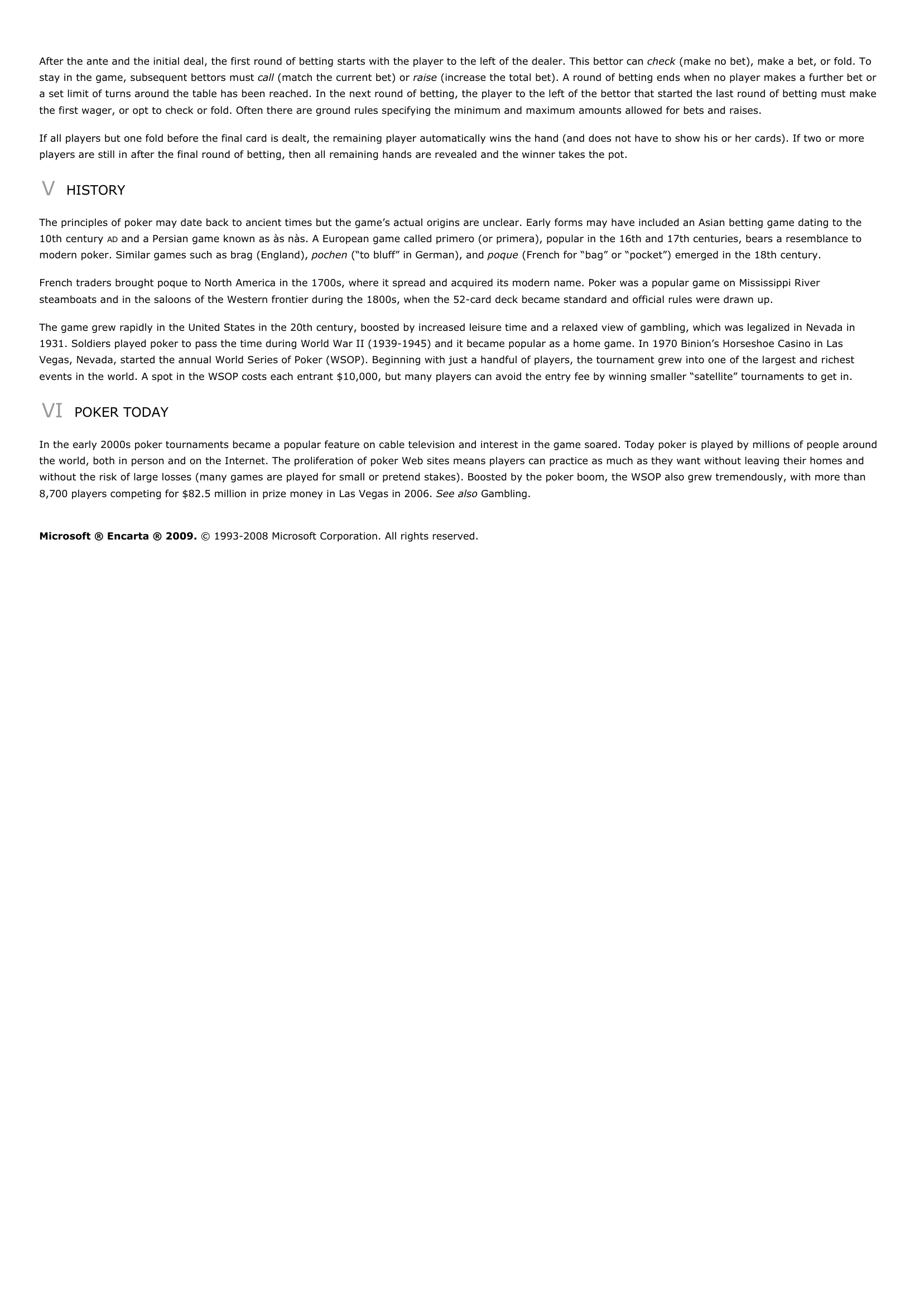Poker.
Publié le 14/05/2013

Extrait du document
«
After the ante and the initial deal, the first round of betting starts with the player to the left of the dealer.
This bettor can check (make no bet), make a bet, or fold.
To stay in the game, subsequent bettors must call (match the current bet) or raise (increase the total bet).
A round of betting ends when no player makes a further bet or a set limit of turns around the table has been reached.
In the next round of betting, the player to the left of the bettor that started the last round of betting must makethe first wager, or opt to check or fold.
Often there are ground rules specifying the minimum and maximum amounts allowed for bets and raises.
If all players but one fold before the final card is dealt, the remaining player automatically wins the hand (and does not have to show his or her cards).
If two or moreplayers are still in after the final round of betting, then all remaining hands are revealed and the winner takes the pot.
V HISTORY
The principles of poker may date back to ancient times but the game’s actual origins are unclear.
Early forms may have included an Asian betting game dating to the10th century AD and a Persian game known as às nàs.
A European game called primero (or primera), popular in the 16th and 17th centuries, bears a resemblance to modern poker.
Similar games such as brag (England), pochen (“to bluff” in German), and poque (French for “bag” or “pocket”) emerged in the 18th century.
French traders brought poque to North America in the 1700s, where it spread and acquired its modern name.
Poker was a popular game on Mississippi Riversteamboats and in the saloons of the Western frontier during the 1800s, when the 52-card deck became standard and official rules were drawn up.
The game grew rapidly in the United States in the 20th century, boosted by increased leisure time and a relaxed view of gambling, which was legalized in Nevada in1931.
Soldiers played poker to pass the time during World War II (1939-1945) and it became popular as a home game.
In 1970 Binion’s Horseshoe Casino in LasVegas, Nevada, started the annual World Series of Poker (WSOP).
Beginning with just a handful of players, the tournament grew into one of the largest and richestevents in the world.
A spot in the WSOP costs each entrant $10,000, but many players can avoid the entry fee by winning smaller “satellite” tournaments to get in.
VI POKER TODAY
In the early 2000s poker tournaments became a popular feature on cable television and interest in the game soared.
Today poker is played by millions of people aroundthe world, both in person and on the Internet.
The proliferation of poker Web sites means players can practice as much as they want without leaving their homes andwithout the risk of large losses (many games are played for small or pretend stakes).
Boosted by the poker boom, the WSOP also grew tremendously, with more than8,700 players competing for $82.5 million in prize money in Las Vegas in 2006.
See also Gambling.
Microsoft ® Encarta ® 2009. © 1993-2008 Microsoft Corporation.
All rights reserved..
»
↓↓↓ APERÇU DU DOCUMENT ↓↓↓
Liens utiles
- FÉLIX VALLOTTON : LA PARTIE DE POKER
- Poker 1 EINLEITUNG Poker, Kartenspiel mit mehreren Varianten, bei dem die Spieler Geld auf den Wert ihrer Karten setzen, um die Kasse (auch ,,Pott" genannt) zu gewinnen, die aus den Einsätzen der Spieler besteht.
- poker.
- JEUX DE CARTES: La Bataille La Belote Le Bog La Canasta Le Chasse-Coeur , La Crapette L'Ecarté La Manille Le May 1 ?• Le Nain jaune Le Pharaon Le Piquet - Le Poker Le Sans-coeur Les Tarots Le Whist
- JEUX DE DÉS: Jeux à deux et à trois dés Jeux de l'Oie Petits chevaux Jacquet Monopoly Dominos Poker dice












